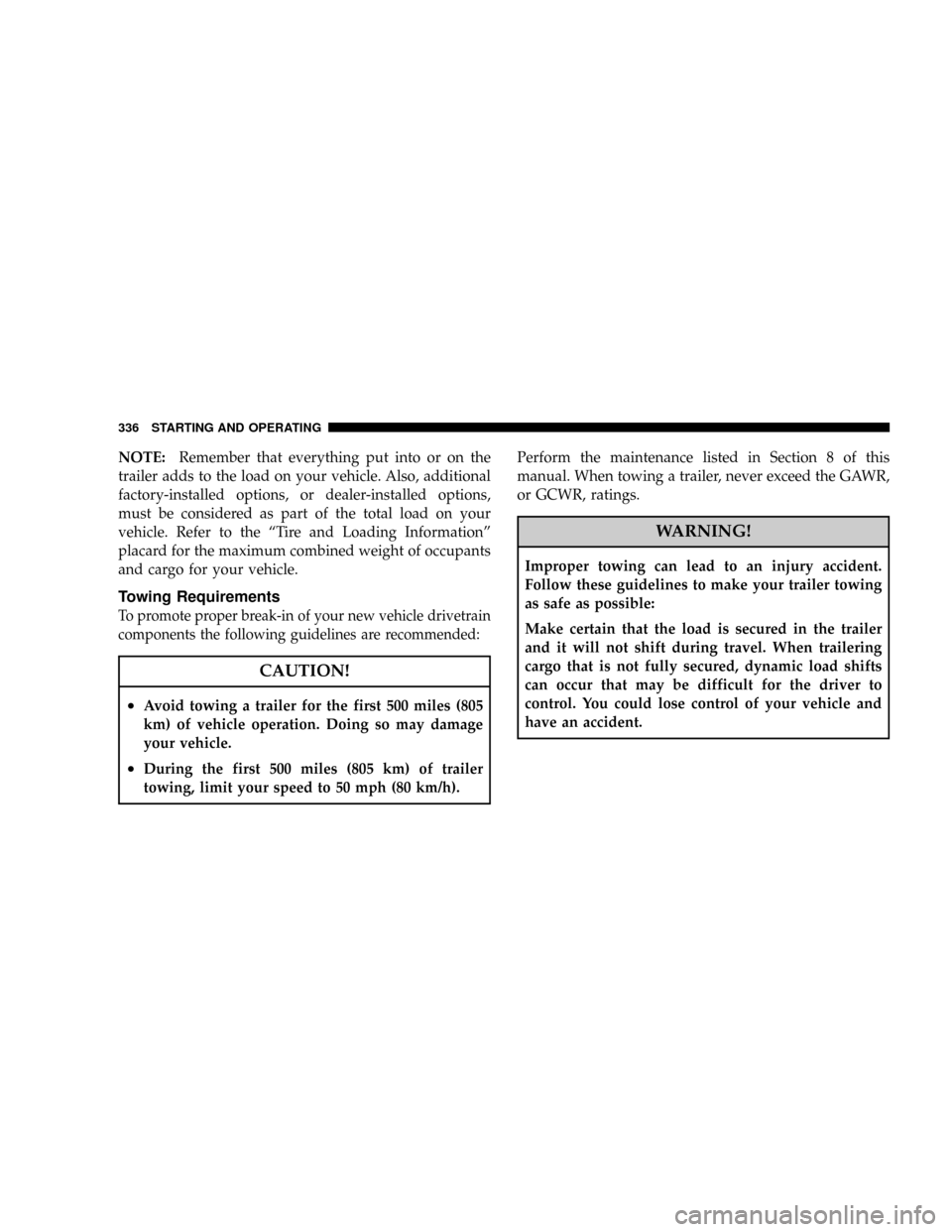Page 327 of 466

WARNING!
Because the front wheels steer the vehicle, it is
important that you do not exceed the maximum front
or rear GAWR. A dangerous driving condition can
result if either rating is exceeded. You could lose
control of the vehicle and have an accident.
Overloading
The load carrying components (axle, springs, tires,
wheels, etc.) of your vehicle will provide satisfactory
service as long as you do not exceed the GVWR and front
and rear GAWR.
The best way to figure out the total weight of your
vehicle is to weigh it when it is fully loaded and ready for
operation. Weigh it on a commercial scale to insure that it
is not over the GVWR.Figure out the weight on the front and rear of the vehicle
separately. It is important that you distribute the load
evenly over the front and rear axles.
Overloading can cause potential safety hazards and
shorten useful service life. Heavier axles or suspension
components do not necessarily increase the vehicle's
GVWR.
Loading
To load your vehicle properly, first figure out its empty
weight, axle by axle and side by side. Store heavier items
down low and be sure you distribute their weight as
evenly as possible. Stow all loose items securely before
driving. If weighing the loaded vehicle shows that you
have exceeded either GAWR, but the total load is within
the specified GVWR, you must redistribute the weight.
Improper weight distribution can have an adverse effect
on the way your vehicle steers and handles and the way
the brakes operate.
STARTING AND OPERATING 327
5
Page 336 of 466

NOTE:Remember that everything put into or on the
trailer adds to the load on your vehicle. Also, additional
factory-installed options, or dealer-installed options,
must be considered as part of the total load on your
vehicle. Refer to the ªTire and Loading Informationº
placard for the maximum combined weight of occupants
and cargo for your vehicle.
Towing Requirements
To promote proper break-in of your new vehicle drivetrain
components the following guidelines are recommended:
CAUTION!
²Avoid towing a trailer for the first 500 miles (805
km) of vehicle operation. Doing so may damage
your vehicle.
²During the first 500 miles (805 km) of trailer
towing, limit your speed to 50 mph (80 km/h).Perform the maintenance listed in Section 8 of this
manual. When towing a trailer, never exceed the GAWR,
or GCWR, ratings.
WARNING!
Improper towing can lead to an injury accident.
Follow these guidelines to make your trailer towing
as safe as possible:
Make certain that the load is secured in the trailer
and it will not shift during travel. When trailering
cargo that is not fully secured, dynamic load shifts
can occur that may be difficult for the driver to
control. You could lose control of your vehicle and
have an accident.
336 STARTING AND OPERATING
Page 349 of 466
3. Remove the fastener securing the spare tire. 4. Remove the spare tire.
5. Remove the fastener securing the jack.
Spare Tire Fastener
Jack Fastener
WHAT TO DO IN EMERGENCIES 349
6
Page 393 of 466

²Keep the front of the radiator clean. If your vehicle is
equipped with air conditioning, keep the front of the
condenser clean, also.
²Do not change the thermostat for summer or winter
operation. If replacement is ever necessary, install
ONLY the correct type thermostat. Other designs may
result in unsatisfactory coolant performance, poor gas
mileage, and increased emissions.
Hoses And Vacuum/Vapor Harnesses
Inspect surfaces of hoses and nylon tubing for evidence
of heat and mechanical damage. Hard or soft spots,
brittle rubber, cracking, tears, cuts, abrasions, and exces-
sive swelling indicate deterioration of the rubber.
Pay particular attention to those hoses nearest to high
heat sources such as the exhaust manifold. Inspect hose
routing to be sure hoses do not come in contact with any
heat source or moving component which may cause heat
damage or mechanical wear.Insure nylon tubing in these areas has not melted or
collapsed.
Inspect all hose connections such as clamps and cou-
plings to make sure they are secure and no leaks are
present.
Components should be replaced immediately if there is
any evidence of wear or damage that could cause failure.
Fuel System
The Electronic Fuel Injection high-pressure fuel system's
hoses and quick connect fittings have unique material
characteristics that provide adequate sealing and resist
attack by deteriorated gasoline.
You are urged to use only the manufacture specified
hoses with quick connect fittings, or their equivalent in
material and specification, in any fuel system servicing. It
is mandatory to replace any damaged hoses or quick
connect fittings that have been removed during service.
MAINTAINING YOUR VEHICLE 393
7
Page 394 of 466

Care should be taken in installing quick connect fittings
to insure they are properly installed and fully connected.
See your authorized dealer for service.
Brake System
In order to assure brake system performance, all brake
system components should be inspected periodically.
Suggested service intervals can be found in the ªMainte-
nance Scheduleº in Section 8 of this manual.
WARNING!
Riding the brakes can lead to brake failure and
possibly an accident. Driving with your foot resting
or riding on the brake pedal can result in abnormally
high brake temperatures, excessive lining wear, and
possible brake damage. You wouldn't have your full
braking capacity in an emergency.
Brake And Power Steering Hoses
When the vehicle is serviced for scheduled maintenance,
inspect surface of hoses and nylon tubing for evidence of
heat and mechanical damage. Hard and brittle rubber,
cracking, tears, cuts, abrasion, and excessive swelling
indicate deterioration of the rubber. Particular attention
should be made to examining those hose surfaces nearest
to high heat sources, such as the exhaust manifold.
Insure nylon tubing in these areas has not melted or
collapsed.
Inspect all hose connections such as clamps and cou-
plings to make sure they are secure and no leaks are
present.
NOTE:
²Often, fluid such as oil, power steering fluid, and
brake fluid are used during assembly plant operations
to facilitate the assembly of hoses to couplings. There-
fore, oil wetness at the hose-coupling area is not
394 MAINTAINING YOUR VEHICLE
Page 408 of 466
Cavity Car-
tridge
FuseMini
FuseDescription
8 Ð 15 Amp
BlueDiagnostic Link Connec-
tor (DLC)/Wireless Con-
trol Module (WCM)/
Wireless Ignition Node
(WIN)
9 Ð 20 Amp
YellowPower Outlet
10ÐÐÐ
11*ÐÐÐ
12*ÐÐÐ
13*ÐÐÐ
14 Ð 10 Amp
RedAC Heater Control/
Cluster/Security Mod-
ule - if equipped
15 Ð 20 Amp
YellowTrailer Tow Brake Mod-
ule - if equippedCavity Car-
tridge
FuseMini
FuseDescription
16ÐÐÐ
17 Ð 20 Amp
YellowCluster
18 Ð 20 Amp
YellowSelectable Power Outlet
19 Ð 10 Amp
RedStop Lights
20ÐÐÐ
21ÐÐÐ
22ÐÐÐ
23ÐÐÐ
24ÐÐÐ
25ÐÐÐ
26ÐÐÐ
408 MAINTAINING YOUR VEHICLE
Page 418 of 466
9. Disconnect the bulb from the socket assembly and
install the replacement bulb.
10. Reinstall the bulb and socket assembly into the tail
light assembly, and then turn it clockwise.
11. Reinstall the tail light assembly, fasteners, electrical
connector, and trunk liner.
12. Close the trunk.
License Light
1. Remove the screws securing the light to the rear fascia.
2. Remove the bulb and socket assembly.
3. Disconnect the bulb from the socket assembly and
install the replacement bulb.4. Reinstall the bulb and socket assembly.
5. Reattach the light to the rear fascia, and then install the
screws.
1 Ð License Light Bulb
2 Ð Socket 418 MAINTAINING YOUR VEHICLE
Page 444 of 466

About Your Brakes....................278,280
ABS (Anti-Lock Brake System).............. 280
Adding Engine Coolant (Antifreeze).......... 390
Adding Fuel........................... 323
Adding Washer Fluid..................132,386
Additives, Fuel......................... 321
Adjustable Pedals....................... 134
Air Cleaner, Engine (Engine Air Cleaner Filter) . . . 379
Air Conditioner Maintenance............... 383
Air Conditioning.....................239,241
Air Conditioning Controls................. 239
Air Conditioning Filter.................248,384
Air Conditioning, Operating Tips............ 249
Air Conditioning Refrigerant.............383,384
Air Conditioning System..........239,241,242,383
Air Pressure, Tires....................172,299
Airbag................................ 50
Airbag Deployment.....................56,60
Airbag Light.....................57,62,77,167Airbag Maintenance....................... 62
Airbag, Side..........................52,58
Airbag, Window (Side Curtain).............52,58
Alarm, Panic............................ 24
Alarm (Security Alarm).................18,172
Alarm System (Security Alarm)............... 18
Alignment and Balance................... 306
All Wheel Drive (AWD)................274,398
Alterations/Modifications, Vehicle............. 7
Antenna, Satellite Radio................... 227
Antifreeze (Engine Coolant)...........389,390,419
Disposal............................ 391
Anti-Lock Brake System (ABS).............. 280
Anti-Lock Warning Light...............173,282
Anti-Theft Security Alarm (Theft Alarm)........ 18
Anti-Theft System....................... 172
Appearance Care........................ 398
Arming Theft System (Security Alarm)......... 18
Audio Systems (Radio).................191,209
444 INDEX